日本的英文介绍
日本英文介绍【精品】
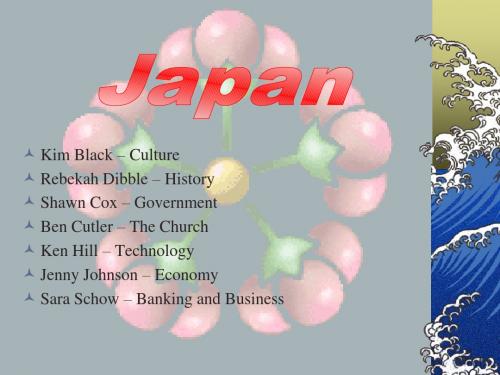
Buddhism
Buddhism was imported to Japan in 538 or 552 in form of a present from the king of the friendly Korean kingdom of Kudara (or Paikche). The new religion was welcomed by the ruling nobles while the common people did not understand its complex theories. Nowadays about 90 million people consider themselves Buddhists in Japan.
History of Japan
Feudal Centuries-Five Main Periods
Kamakura Period (1185-1333) Muromachi Period (1333-1576) Momoyama Period (1576-1600) Christian Century (1543-1640) Tokugawa Period (1600-1867)
Customs & Etiquette
Remove shoes, two kinds of slippers No tipping Restrooms, B.Y.O.T.P. Importance of gifts, often food Slurping, chopsticks, and other dining advice
Map of Japan
Regional Differences & Diversity
Speed Train
介绍日本京都的英文作文

介绍日本京都的英文作文英文:Kyoto is one of the most beautiful and culturally rich cities in Japan. As a resident of Kyoto, I feel proud to introduce this city to you.First of all, Kyoto is famous for its numerous temples and shrines. There are over 2,000 temples and shrines in Kyoto, including the famous Kiyomizu-dera Temple, Fushimi Inari Shrine, and Kinkaku-ji Temple. These temples and shrines are not only religious sites but also represent the unique Japanese culture and history.Secondly, Kyoto is a foodie's paradise. There are many traditional Japanese dishes that originated in Kyoto, such as Kaiseki cuisine, which is a multi-course meal that features seasonal ingredients and is beautifully presented. Another famous Kyoto dish is Yudofu, which is a simple tofu hot pot that is perfect for cold winter days.Lastly, Kyoto is a city of festivals. There are many festivals throughout the year, such as the Gion Matsuri in July, which is one of the most famous festivals in Japan. During the festival, the streets of Kyoto are filled with people dressed in traditional Japanese clothing, and there are many food stalls and performances.中文:京都是日本最美丽和文化丰富的城市之一。
英文国家介绍日本课件

The four seasons are distinct, with hot and humid summers and cold and snowy winters.
Affected by the ocean, Japan has a mild climate with relatively small annual temperature differences.
Meiji Restoration: In 1868, Japan underwent the Meiji Restoration and began to embark on the path of capitalism, rapidly rising to become a world power.
Nagoya
An important city in central Japan, it is the capital of Aichi Prefecture and an important industrial and transportation hub.
Sapporo
Located in Hokkaido, it is the largest city on the island and is known for its unique winter culture and rich outdoor activities.
Japan is an island country in the Pacific Ocean, facing China, North Korea, South Korea, and other countries across the East China Sea, Yellow Sea, Korean Strait, and Sea of Japan to the west.
大日本帝国的英文介绍
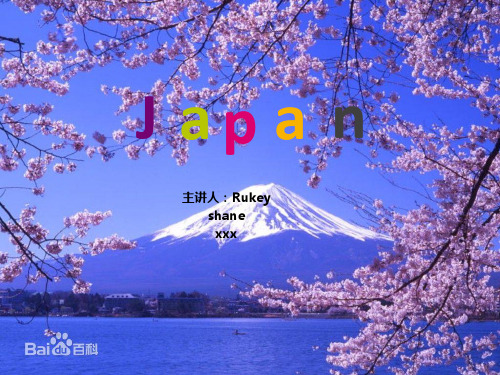
Geography
北海道Hokkaido [hɔ'kaidəu] 本州 Honshu ['hɔnʃu:] 四国 Shikoku ['ʃi:kəu,ku:] 九州 Kyushu ['kju:ʃu:]
Geography
Northern monsoon climate of medium latitudes Southern subtropical monsoon climate
每年日本的樱花会从南向北 次第开花,所以日本有个 词叫樱花前线
The Japanese Tea Ceremony
The Japanese tea ceremony is an artistic pastime unique to Japan. Japanese green-tea had been introduced to Japan from China around the 8th As an art, The Tea Ceremony is an occasion to appreciate the simplicity of the tea room’s design, the feel of the Chawan(茶碗) in the hand, the company of friends, and simply a
Geography
Geography
Geography
Geography
Topography (地形) Mountainous region(75%) Plain(25%)
Common traits(特点)
Modest (谦虚)
Timid (胆小)
Common traits(特点)
Common traits(特点)
日本简介 英汉对照
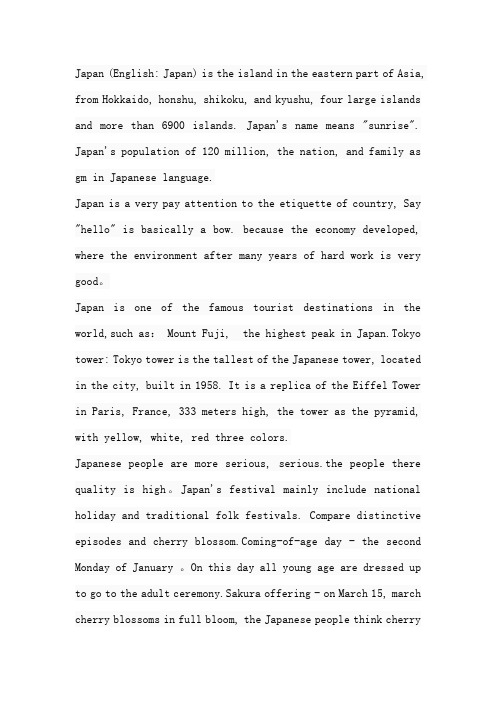
Japan (English: Japan) is the island in the eastern part of Asia, from Hokkaido, honshu, shikoku, and kyushu, four large islands and more than 6900 islands. Japan's name means "sunrise". Japan's population of 120 million, the nation, and family as gm in Japanese language.Japan is a very pay attention to the etiquette of country, Say "hello" is basically a bow. because the economy developed, where the environment after many years of hard work is very good。
Japan is one of the famous tourist destinations in the world,such as: Mount Fuji, the highest peak in Japan.Tokyo tower: Tokyo tower is the tallest of the Japanese tower, located in the city, built in 1958. It is a replica of the Eiffel Tower in Paris, France, 333 meters high, the tower as the pyramid, with yellow, white, red three colors.Japanese people are more serious, serious.the people there quality is high。
用英语介绍日本的景点

用英语介绍日本的景点Japan's Must-See Tourist AttractionsJapan is a country that is rich in culture, history, and natural beauty. From the bustling city of Tokyo to the serene temples of Kyoto, there are countless tourist attractions that draw visitors from all over the world. In this article, we will explore some of Japan's must-see tourist attractions that showcase the country's unique charm and beauty.Tokyo Disneyland and DisneySeaTokyo Disneyland and DisneySea are two of the most popular tourist attractions in Japan. Located in Chiba, just outside of Tokyo, these theme parks offer a magical experience for visitors of all ages. Tokyo Disneyland features classic Disney attractions such as Space Mountain and the Haunted Mansion, while DisneySea offers a more unique experience with attractions themed around differentports of call. Both parks are beautifully designed andoffer a wide range of entertainment options, making them a must-visit for any Disney fan.Mount FujiMount Fuji is Japan's highest mountain and a symbol of the country's natural beauty. Located about 100 kilometers southwest of Tokyo, Mount Fuji is an iconic sight that can be seen from miles away on a clear day. Visitors can take a bus tour to the fifth station of the mountain, where they can enjoy panoramic views of the surrounding landscape. For the more adventurous, climbing Mount Fuji is a popular activity during the summer months. The mountain's perfectly symmetrical cone shape and stunning views make it a must-see attraction for nature lovers.Hiroshima Peace Memorial ParkHiroshima Peace Memorial Park is a powerful and moving tribute to the victims of the atomic bomb that was dropped on the city during World War II. The park is home toseveral important monuments and memorials, including the A-Bomb Dome, which is the remains of a building that was near the epicenter of the blast. The park also features the Peace Memorial Museum, which provides a comprehensive lookat the events leading up to and following the bombing. Avisit to Hiroshima Peace Memorial Park is a sobering but important experience that offers a chance for reflectionand remembrance.Kyoto's Historic Temples and ShrinesKyoto is home to some of Japan's most beautiful and historic temples and shrines, making it a must-visit destination for anyone interested in Japanese culture and history. Kinkaku-ji, also known as the Golden Pavilion, is one of Kyoto's most famous attractions, with its stunning gold leaf exterior and serene garden. Fushimi Inari Taishais another popular destination, known for its thousands of vermillion torii gates that wind through the forested hills. Other must-see temples and shrines in Kyoto includeKiyomizu-dera, Ginkaku-ji, and Ryoan-ji, each offering its own unique beauty and history.Okinawa's Beaches and IslandsOkinawa is a tropical paradise located in the southernmost part of Japan, known for its stunning beaches, crystal-clear waters, and unique culture. The main islandof Okinawa is home to beautiful beaches such as Katsuren Peninsula Beach and Sunset Beach, which offer opportunities for swimming, snorkeling, and relaxation. Additionally, the surrounding islands of Ishigaki, Miyako, and Iriomote offer even more opportunities for outdoor activities and exploration. Okinawa's distinct culture, including its traditional music, dance, and cuisine, make it a must-visit destination for anyone looking to experience a different side of Japan.Nara's Deer Park and Todai-ji TempleNara is a city located in the Kansai region of Japan, known for its friendly deer and impressive temples. Nara Park is home to over 1,000 free-roaming deer that are considered sacred and are a popular attraction for visitors.The park is also home to several important temples, including Todai-ji, which houses a giant bronze Buddha statue and is one of Japan's most famous and historically significant temples. Visitors can also explore the nearby Kasuga Taisha Shrine, known for its thousands of hanging lanterns that create a magical atmosphere.These are just a few of the many must-see tourist attractions in Japan. Whether you're interested in history, culture, nature, or theme parks, Japan offers something for everyone. With its unique blend of tradition and modernity, Japan is a country that is sure to captivate and inspire visitors from all over the world.。
介绍日本英文PPT
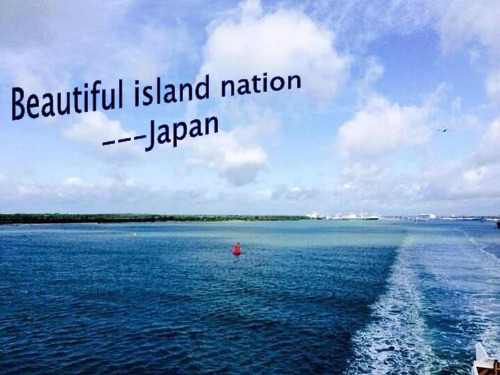
Mount
Fuji is Japan‘s tallest peak, a symbol of the Japanese nation, the Japanese people as the "sacred mountain”
日本“圣岳”——富士山富士山是日本第一 高峰,是日本民族的象征,被日本人民誉为 “圣岳”
茶道是日本文化的代表之 一。它集结了日本文化诸 多的特点和精华,形成了 一个综合的文化体系。
Atomic bombardment (6th Augest,1945) 88,000 died that day
Theうもありがとうございます
Tea is one of the representative of the Japanese culture. It assembled Japanese culture of many characteristics and essence, forming a comprehensive cultural system
1. Cherry blossoms& Mount Fuji 樱花盛开&富士山
2. Japanese food
日本美食
3.Anime
动漫
Cherry blossom (Sakura)
cherry blossom is a national flower of Japan. In the middle of every march to mid April, is a season that Japanese coming from the south to the north to appreciate it.Every year attracts many tourists .
Japan Introduction 日本的英文介绍 (课堂PPT)
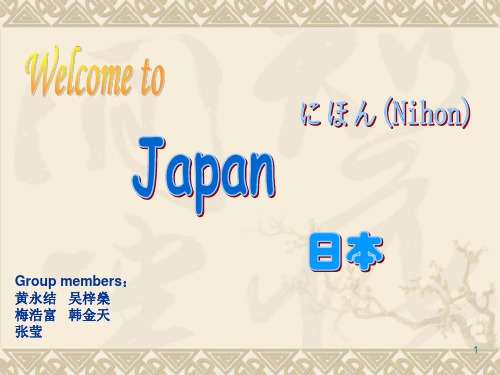
National Flag
One of the simplest flags, as well as one of the easiest to recognize, the Japanese flag comprises a white background with a striking red disk in the center.
19
First Step
Asakusa Temple 浅草寺
20
Asakusa Temple
• Asakusa Temple was built in 628. •It is the most age-old temple in Tokyo. •In the Edo Age, the general Leyasu Tokugawa named here as the place for shogunates to pray.
②The white background of the flag is said to represent honesty and purity.
2
The location of Japan in the world Japan is an island country located outside the east coast of Asia.
邮票
❖ 検討 ❖ 勉強 ❖ 面白い
❖ 無料/有料
反省 不情愿 肤色白
研究调查 学习 有趣
没本事/有本事(Cantonese) 免费/收费
12
Content:
❖ Scenery 自然景观 --------------------------------------------张莹
英文版日本文化介绍 Japanese culture

creamy sauces and strong smelling foods
Food & Drink in China
Chinese habits:
•always a cup, a bowl on a small dish, together with the chopsticks and table spoons •cooked food •whole plate of dishes for everyone •accompanied by tea, beer or distilled spirit •required to keep silent
Long term orientation
•See their life as a very short moment in a long history of mankind
•Live their lives guided by virtues and practical good examples
avoid
in obtrusive way complain directly
Business Etiquette in Japan
Rachel
Appointments Appearance Meet & Greet Business cards Business seating order Business dealings Decisions & Contracts Giving gifts
Business Customs in Japan
ONE
Overall Situation of Japan
TWO
日本的景英文介绍带翻译
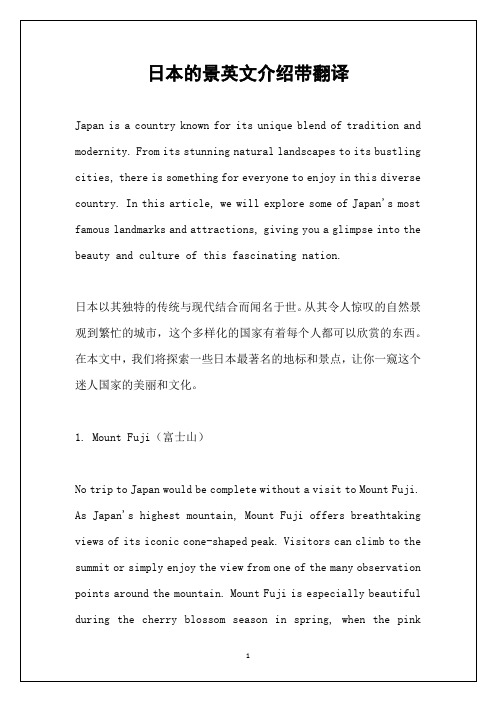
The Great Buddha of Kamakura is a towering bronze statue located in the coastal town of Kamakura. Constructed in the 13th century, this 43-foot statue represents Amitabha Buddha and is a symbol of peace and compassion. Visitors can enter the statue to marvel at its size and intricate details. Surrounding the statue is the beautiful Kotoku-in Temple, which is worth exploring after admiring the Great Buddha.
没有去日本旅行可以没有富士山的参观。作为日本最高的山脉,富士山以其标志性锥形的山峰提供了令人叹为观止的景色。游客可以爬上山顶,也可以从山脚下的众多观景点欣赏美景。富士山在春天的樱花季节尤为美丽,粉色的花朵与雪覆盖的山峰形成鲜明的对比。
2. The Great Buddha of Kamakura(镰仓大佛)
东京,日本的首都,是一个繁忙的大都市,将现代摩天大楼与古老的寺庙和神社结合在一起。在东京,你可以参观著名的东京塔,俯瞰城市全景,探索传统的浅草区,并沉浸在原宿的活力街头文化中。当你在东京时,别忘了尝试一些美味的寿司或拉面,因为这个城市以其独特的美食而闻名。
Japan Introduction 日本的英文介绍(课堂PPT)
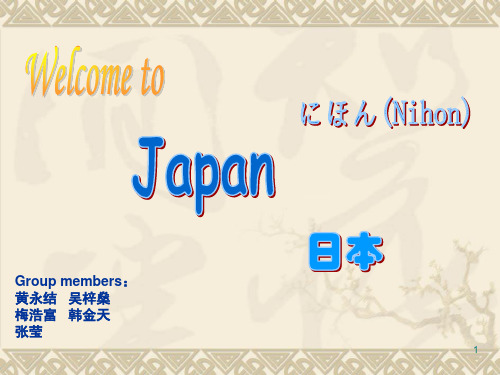
Hiragana (平假名)
Katakana(片假名)
9
私は学生です-----我是学生。 I am a student. わたし――――主语 / subject 学生ですーーー谓语/ predicate はーーーー提示助词,把句子里的主题提示出来,放在名词/数词/代词之后。此时读wa。 です-------是助动词,表示断定,相当于English中的"to be"
19
First Step
Asakusa Temple 浅草寺
20
Asakusa Temple
• Asakusa Temple was built in 628. •It is the most age-old temple in Tokyo. •In the Edo Age, the general Leyasu Tokugawa named here as the place for shogunates to pray.
Group members: 黄永结 吴梓燊 梅浩富 韩金天 张莹
1
National Flag
One of the simplest flags, as well as one of the easiest to recognize, the Japanese flag comprises a white background with a striking red disk in the center.
Asian
Japan
Pacific
3
北海道
Japan is made up of 4 major islands
and about several thousands small islands.
日本 英文介绍

JapanJapanAdd To WorkspaceBritannica Elementary ArticleOnline SearchWorld DataView Table of ContentsNotes ViewerMinimize ToolbarMaximize ToolbarFindPrintSaveBookmarkPreferencesTake a NoteShow NotesHide NotesIntroductionFlag of JapanJapan is a country marked by contrast between old and new. The country values its complex and ancient cultural tradition. Yet life in modern Japan is increasingly focused on cities and modern technology. In the second half of the 1900s, Japan emerged as one of the world's most economically and technologically advanced societies.Japan is located off the east coast of Asia. The country consists of a string offour large islands and more than 3,900 smaller islands. From north to south, the main islands are Hokkaido, Honshu, Shikoku and Kyushu. The largest is Honshu, which is regarded as the Japanese mainland. The Ryukyu Islands, including Okinawa, arc to the south and west of Kyushu. Tokyo, on Honshu, is the capital and one of the world's largest cities.GeographyThe islands of Japan form an arc that stretches about 2,400 kilometres (1,500 miles) from north-east to south-west. Japan has no land border with any other country. The open waters of the Pacific Ocean border Japan's eastern andsouth-eastern shores. China is to the south-west, across the East China Sea.North and South Korea are to the west, across the Sea of Japan. Russia lies across the Sea of Japan to the north-west and the Sea of Okhotsk to the north. Japan has a total land area of 377,835 kilometres (145,883 square miles). Mountains cover more than 80 per cent of Japan's land surface. They divide the islands into hundreds of smaller sections. The largest and highest mountain mass lies in central Honshu. Part of the range is known as the Japanese Alps. Manyshort river valleys and small lowland plains interrupt the mountain ranges. Mostof the plains lie along the coast.Japan experiences hundreds of earthquakes every year. Most of them are minor, but a few are devastating. Undersea earthquakes sometimes stir up tsunamis, or huge sea waves. The country also has many volcanoes, both active and inactive. Mount Fuji, in central Honshu, has been inactive since 1707. With a height of3,776 metres (12,388 feet), it is Japan's highest mountain.Plants and AnimalsMuch of Japan's original vegetation has been replaced by farming or by plant species brought in from other countries. Forests cover a large part of the land. Pine, cypress, hemlock, cedar, fir and spruce are commercially valuable evergreens. The numerous broad-leaved trees include oak, maple, ash, birch, beech and poplar. Bamboo and palms grow in southern and central Japan.The cherry tree is planted throughout the country and occurs naturally in partsof the mountains. It is celebrated for its beautiful spring blossoms. The cherrytree has long been one of the symbols of Japan.Many animals live in the country's remote, forested mountain regions. The mammals include bears, foxes, deer, wild boars, antelope, hares and wild monkeys. The seas are home to whales, dolphins, porpoises and a wide variety of commercially valuable fish. The raising of goldfish and colourful carp for decorative purposes is a Japanese speciality.PeopleThe great majority of the Japanese people share the same ethnic and cultural background. They are closely related to the other peoples of eastern Asia. There are, however, several minority groups. Koreans form the largest minority group. Many of them were born in Japan. The burakumin (‘people of the village') are ethnically the same as the majority of Japanese. However, their ancestors were members of the former outcast class. The burakumin are often treated unfairly.In addition, there are small numbers of Ainu, a native people of northern Japan. The relatively tiny foreign community in Japan is composed largely of Chinese.Buddhists visit the Kiyomizu temple, in Kyoto, Japan.The country's official language is Japanese. Shinto and Buddhism are the main religions. Shinto is based on the worship of local spirits in nature. Itoriginated in Japan. A small proportion of the population is Christian. On Honshu are most of Japan's largest cities, including Tokyo, Yokohama, Osaka, Kobe, Nagoya, Kyoto, Kawasaki and Hiroshima. About 80 per cent of the country's people live on Honshu.CultureJapan has a rich and complex culture. Native Japanese traditions have been mixed with cultural styles adapted from China and, later, from the West. Japaneseculture and art emphasise understated simplicity, elegance and grace. For example, the traditional Japanese tea ceremony, flower arranging and gardendesign are highly stylised and refined. On the other hand, contemporary Japanese society fully embraces Western-style popular culture – influenced by television,films and advertising.LiteratureJapan has a long and vibrant literary tradition. The Tale of Genji is consideredthe world's first important novel. It was written in the early 1000s by Shikibu Murasaki, a lady of the Kyoto court. Renowned modern Japanese writers include Soseki Natsume, Ryunosuke Akutagawa, Osamu Dazai, Jun'ichiro Tanizaki and Yukio Mishima. Japanese novelist Yasunari Kawabata won the Nobel Prize for Literaturein 1968.Poetry plays a central role in Japanese culture. Occasions of many kinds are celebrated with poems. The most common forms are haiku and tanka – short, unrhymed poems with a certain number of syllables in each line.Visual ArtsIn classical Japanese painting, black ink and watercolours were used ontissue-thin silk. The carefully composed paintings used few brush strokes tosuggest a scene in nature. Ukiyo-e, or ‘pictures of the floating world',depicted the life of common people. Japanese woodcuts of the 1600s and 1700swere among the finest examples of ukiyo-e.Performing ArtsTraditional Japanese theatre combines music, dance and drama. In puppet plays called Bunraku, nearly life-sized dolls are used to act out a chanted story.Japanese No plays are generally short, stylised and heroic. The actors andchorus chant fine poetry. While No theatre was originally restricted to theupper classes, Kabuki was the theatre of the townspeople and farmers. Kabukiplays are colourful spectacles of singing, dancing, mime and melodrama.Martial ArtsThe martial arts in Japan originated with medieval warriors, the samurai, whoused them in battle. Today the martial arts are more important as competitivesports and as aids to physical and mental fitness. The most popular forms aresumo wrestling, judo, aikido, karate and kendo.EconomyJapan was defeated in World War II (1939–45), with great loss of life and property. Yet after the war it emerged as one of the most advanced economicpowers in the world. The Japanese economy grew remarkably throughout the 1960s, 1970s and 1980s. Manufacturing developed especially rapidly. However, the economy slowed greatly in the early 1990s and suffered a major downturn at theend of the decade. Nevertheless, Japan remained an economic superpower.Japan's economy has revolved primarily around manufacturing and trade. TheJapanese are the leading makers of ships, cars and advanced electronics and equipment – especially television sets, DVD players, computers, cameras, microwave ovens, watches, photocopiers and robots. The country has some of the world's largest and most advanced industrial plants. It is a major producer ofcrude steel, synthetic rubber, aluminium, chemicals, plastics, cement and pulpand paper.Farming and fishing contribute only about two per cent of the national income.Rice is the most important food and the main crop. Other leading crops include wheat, barley, potatoes, sugar beets, fruit, vegetables and tea. A small numberof cattle and hogs are raised. Japan relies heavily on the sea as a source offood. It has one of the largest fish catches of any nation in the world.HistoryAncient JapanPeople were living in Japan at least 10,000 years ago. According to legend, the Japanese state was founded in 660 BC by the emperor Jimmu. Historical records, however, show that Japan was not united as one state until the late AD 300s or400s. It was ruled by the Yamato dynasty.During the Yamato period, Buddhism arrived in Japan from Korea. In addition, for many centuries the Japanese borrowed heavily from Chinese culture. The Japanese adopted Chinese characters to write the Japanese language. Imperial courts basedon Chinese models appeared in Japan in the 700s.From the 800s to the 1100s the Fujiwara family dominated Japan. This period wasa classic age of art and literature. Japan's culture no longer borrowed fromChina but became distinctively Japanese.Military GovernmentDuring the 1100s a class of warriors called samurai rose to power. However, the emperor continued to hold some authority. The samurai had sophisticated military skills. They developed a disciplined way of living, which followed a code ofconduct based on loyalty and sacrifice.In the late 1100s Yoritomo Minamoto established Japan's first militarygovernment at Kamakura. Minamoto was named shogun, or chief military commander, and his government was called a shogunate. Except for periods of internalwarfare, this form of government persisted until 1868.Meanwhile, Japan was developing trade contacts with the outside world. Official trade missions to China began in 1404. In 1543, Portuguese traders arrived,followed by the Spanish, English and Dutch. Some of the Japanese converted to Christianity.UnificationThe government's division and disorder ended in the late 1500s. By 1590 Toyotomi Hideyoshi had brought the region under his control. After Hideyoshi's death in 1598, his supporter Ieyasu Tokugawa took over. Under Tokugawa, the country was again united under a strong shogunate.For the next two centuries, Japan enjoyed great peace and stability. A nationalmarket developed, and the economy flourished. Advances were made in farming techniques. Osaka and Edo (now named Tokyo) became great commercial and cultural centres.The period was also marked by isolation. The Tokugawa government feared that Japan was being prepared for foreign conquest. The Tokugawa banned Christianity and expelled almost all foreigners. Japan cut back on foreign trade. Inaddition, the Japanese were forbidden to leave the country.By the mid-1800s the Tokugawa shogunate was unable to keep European and United States traders away. The Tokugawa's support among the Japanese people collapsed.In 1868 the Tokugawa shogun was forced to step down.The Meiji EmperorA new government was established under the young emperor Mutsuhito, who took the name of Meiji, meaning ‘enlightened government'. This transfer of power from the Tokugawa shogunate to the Meiji emperor is known as the Meiji Restoration. It is regarded as the beginning of Japan's modern era.ExpansionJapan soon sought to build an empire. It successfully fought a war with China (1894–95) and with Russia (1904–05). As a result, Japan took over some of thetwo countries' possessions in East Asia. It made Korea into a Japanese colony in 1910.During World War I (1914–18), Japan fought on the side of the Allied powers (mainly Britain, France and Russia). The Allied powers won the war. Japan's involvement was limited, but it seized additional territory in East Asia from Germany.World War IIBy 1930 Japan faced a financial crisis. The Japanese government believed that expansion through military conquest would help the economy. In 1931 Japan seized Manchuria from China. Japan moved troops into China in 1937 and into French Indochina in 1940. The Japanese signed the Tripartite Pact, forming an alliancewith Germany and Italy. The three countries formed the Axis powers. They fought against the Allied powers, mainly Britain, France, Russia and China during World War II.The United States tried to stop Japan's aggression in East Asia by banning shipments of oil to Japan. In December 1941 Japan attacked the United Statesforces at Pearl Harbor, Hawaii, which pulled the United States into war. After experiencing early successes on every front, the Japanese forces were gradually pushed back by the United States and other Allied troops. In August 1945 theUnited States dropped atom bombs on the Japanese cities of Hiroshima and Nagasaki. The cities were largely destroyed. Shortly thereafter the Japanese surrendered. (See also World War II.)Post-war JapanUnder the terms of surrender, Japan had to give up all the territory it hadacquired since 1895. In addition, United States forces occupied Japan until 1952. Japan's military was disbanded. Political, social and educational reforms encouraged the growth of democracy. A new constitution in 1947 gave great power to the elected legislature and took power away from the emperor.Japan rebuilt its ruined economy, using new technology in every major industry. Its spectacular growth was called an ‘economic miracle'. By the 1990s Japan had one of the world's largest economies. After 1990 growth slowed considerably, but the economy showed a small upturn again in the early 2000s. Population (2007 estimate), 127,433,000.Back to TopTo cite this page:MLA Style: "Japan." Britannica Elementary Library. Encyclopdia BritannicaStudent and Home Edition. Chicago: Encyclopdia Britannica, 2011.APA Style: Japan. (2011). Britannica Elementary Library. EncyclopdiaBritannica Student and Home Edition. Chicago: Encyclopdia Britannica.Table of Contents : Notes ViewerLoading...CloseDelete Selected Notes。
日本文化介绍(全英文版)

Composition
• The main islands, sometimes called the "Home Islands", are (from north to south) Hokkaidō, Honshū (the "mainland"), Shikoku and Kyūshū. There are also about 3,000 smaller islands, including Okinawa, and islets, some inhabited and others uninhabited. In total, as of 2006, Japan's territory is 377,923.1 km² , of which 374,834 km²is land and 3,091 km²water. This makes Japan's total area slightly smaller than the U.S. state of Montana, slightly bigger than the Brazilian state of Mato Grosso do Sul. Japan is bigger than Germany, Malaysia, New Zealand and the U.K., and is 1.7 times the (和服)
The kimono is a Japanese traditional garment worn by women, men and children. The word "kimono", which literally means a "thing to wear" (ki "wear" and mono "thing"), has come to denote these full-length robes. The standard plural of the word kimono in English is kimonos,[but the unmarked Japanese plural kimono is also sometimes used. Kimono are T-shaped, straight-lined robes worn so that the hem falls to the ankle, with attached collars and long, wide sleeves. Kimono are wrapped around the body, always with the left side over the right (except when dressing the dead for burial),[and secured by a sash called an obi, which is tied at the back. Kimono are generally worn with traditional footwear and split-toe socksToday, kimono are most often worn by women, and on special occasions. Traditionally, unmarried women wore a style of kimono called furisodewith almost floor-length sleeves, on special occasions. A few older women and even fewer men still wear the kimono on a daily basis. Men wear the kimono most often at weddings, tea ceremonies, and other very special or very formal occasions. Professional sumo wrestlers are often seen in the kimono because they are required to wear traditional Japanese dress whenever appearing in public
关于介绍日本的英语文章
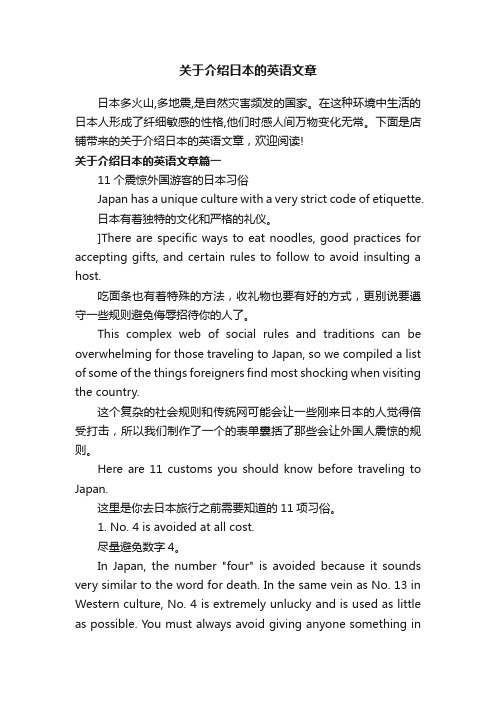
关于介绍日本的英语文章日本多火山,多地震,是自然灾害频发的国家。
在这种环境中生活的日本人形成了纤细敏感的性格,他们时感人间万物变化无常。
下面是店铺带来的关于介绍日本的英语文章,欢迎阅读!关于介绍日本的英语文章篇一11个震惊外国游客的日本习俗Japan has a unique culture with a very strict code of etiquette.日本有着独特的文化和严格的礼仪。
]There are specific ways to eat noodles, good practices for accepting gifts, and certain rules to follow to avoid insulting a host.吃面条也有着特殊的方法,收礼物也要有好的方式,更别说要遵守一些规则避免侮辱招待你的人了。
This complex web of social rules and traditions can be overwhelming for those traveling to Japan, so we compiled a list of some of the things foreigners find most shocking when visiting the country.这个复杂的社会规则和传统网可能会让一些刚来日本的人觉得倍受打击,所以我们制作了一个的表单囊括了那些会让外国人震惊的规则。
Here are 11 customs you should know before traveling to Japan.这里是你去日本旅行之前需要知道的11项习俗。
1. No. 4 is avoided at all cost.尽量避免数字4。
In Japan, the number "four" is avoided because it sounds very similar to the word for death. In the same vein as No. 13 in Western culture, No. 4 is extremely unlucky and is used as little as possible. You must always avoid giving anyone something infours because it can be seen as a very ominous gift.在日本,数字"4"因为听起来像"死"字所以被尽量避免。
- 1、下载文档前请自行甄别文档内容的完整性,平台不提供额外的编辑、内容补充、找答案等附加服务。
- 2、"仅部分预览"的文档,不可在线预览部分如存在完整性等问题,可反馈申请退款(可完整预览的文档不适用该条件!)。
- 3、如文档侵犯您的权益,请联系客服反馈,我们会尽快为您处理(人工客服工作时间:9:00-18:30)。
每年日本的樱花会从南向北 次第开花,所以日本有个 词叫樱花前线
In Japanese,the cherry is called “sakura”,which is generally believed to be a corruption of the word “sakura” blooming from the name of princess kono-HanaSakura-Hime
Common traits(特点)
Japanese are very good at maximizing their value in team work,so that we always have the sense that Japanese are very timid(胆小).On the other hand Japanese treat everything seriously,they have strong sense of discipline(纪律感),when it comes to this,we can see them as an abnormal (变态) nation . Not only are they modest,but also they are very polite.However ,to some extend,they are a very flattering(谄媚) nation .They have no idea how to create and innovate(创新),but they are expert in transformation(改造) and innovation on the basis of existing st but not the least ,Japanese have great sense of crisis (危机感)。
clothes
Kimono
• Kimono is a traditional Japanese national costume call. Japan also said it "fixtures." Is modeled on the Chinese Sui and Tang dynasties kimono-style clothes and Miss service reforms, in Japan known as "Miss clothes" and "Tang Yi," Although changes in Japan after the formation of a unique style, but still contain some Chinese clothing characteristics. Women's kimono style and color difference is that the display between age and whether marriage or not .For example, unmarried girls wear tight sleeves, suits, married women wear clothes, full sleeve;the red shirt from the girl, wearing of plain is a housewife. Kimono have no buttons, just a knot belt
Samurai(日本武士)
If one samurai make a big mistake,he should
Seppuku(切腹自杀)
Samurai(日本武士)
food
Sushi(寿司) is a kind of rice topped with vegetables. It is a spectacular combination of various ingredients including rice, fish (鱼)and vinegar (醋)and is the most representative Japanese cuisine.
J apan
日本
主讲人:xxx Xxx xxx
culture
economy
geography
Japan
Traits of Japanese
Culture of Japan clothes food
The Japanese Tea Ceremony
cherry blossom
Culture of Japan is rooted from china.
The Japanese Tea Ceremony
The Japanese tea ceremony is an artistic pastime unique to Japan. Japanese green-tea had been introduced to Japan from China around the 8th As an art, The Tea Ceremony is an occasion to appreciate the simplicity of the tea room’s design, the feel of the Chawan(茶碗) in the hand, the company of friends, and simply a
Geography
Geography
Geography
Geography
Topography (地形) Mountainous region(75%) Plain(25%)
Common traits(特点)
Modest (谦虚)
Timid (胆小)
Common traits(特点)
Common traits(特点)
food
food
food
food
cherry blossom(樱花)
cherry blossom(樱花)
Japan‘s cherry blossoms every year from south to north sequence flowering, so the Japanese have a word called cherry front (樱花前线)
The Japanese tea ceremony
• Also called the tea ceremony tea (tea), as a beauty since ancient times on the upper reaches of the ceremony are very popular. Now, the tea ceremony to be used as training concentration, or for training ritual behavior, for the general public are widely accepted. Japan has many schools teach the techniques of the tea ceremony schools, many hotel also has a teahouse, you can easily enjoy the tea ceremony performance. However, the Japanese tea ceremony ultimately a matter for the Chinese Tang dynasty Zhenguan years spread to Japan.
Cluture of Japan
• Japan's unique geographical conditions and a long history bred a unique Japanese culture. Sakura, kimono, haiku and samurai, Sake, a traditional Shinto Japan's two aspects Chrysanthemum and the Sword. In Japan there are the famous “Three", that is, the Japanese people of the tea ceremony, ikebana, handwriting.
Geography
北海道Hokkaido [hɔ'kaidəu] 本州 Honshu ['hɔnʃu:] 四国 Shikoku ['ʃi:kəu,ku:] 九州 Kyushu ['kju:ʃu:]
ห้องสมุดไป่ตู้
Geography
Northern monsoon climate of medium latitudes Southern subtropical monsoon climate
日本独特的地理条件和悠久的历史,孕育了别具一格的日 本文化。樱花、和服、俳句与武士、清酒、神道教构成了 传统日本的两个方面——菊与剑。在日本有著名的 "三道 ",即日本民间的茶道、花道、书道。
clothes
Kimono(和服) Kimono(和服) is Japan‘s national costume, the highly traditional Japanese culture for hundreds of years and the Japanese life closely linked. Even today, whenever there’s a holiday or a wedding(婚礼), funeral(葬礼), graduation ceremonies and celebrations such as a grand occasion, the Japanese kimono is still the first choice.
